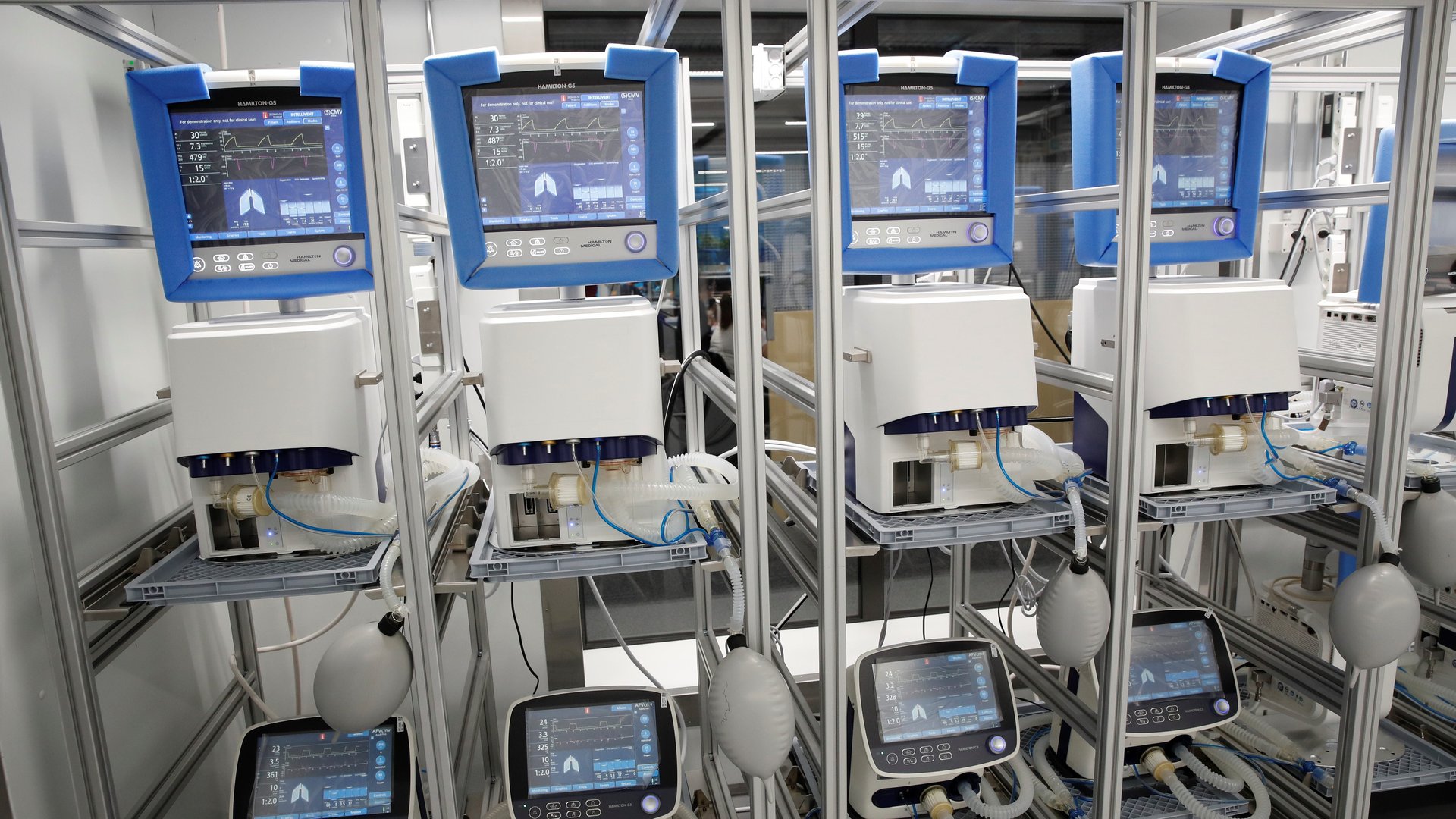Some drugs used to keep coronavirus patients on ventilators are in short supply
According to the American Hospital Association, about 1% of people infected with the novel coronavirus need ventilators to survive. With the spread of the virus around the globe, those breathing machines are precious commodities; the US is expected to be short some 800,000 of the breathing machines by some estimates.


According to the American Hospital Association, about 1% of people infected with the novel coronavirus need ventilators to survive. With the spread of the virus around the globe, those breathing machines are precious commodities; the US is expected to be short some 800,000 of the breathing machines by some estimates.
In addition to the machines, though, states may also have to deal with the shortage of medications required to keep a person on a ventilator. The American Society of Health-Systems Pharmacists (ASHP) has reported that as of mid-March, five drugs associated with ventilator use were officially in short supply. While it may not be that the spread of Covid-19 is causing these shortages, the pandemic is certainly exacerbating them.
The ASHP defines a shortage as “a supply issue that affects how the pharmacy prepares or dispenses a drug product or influences patient care when prescribers must use an alternative agent.” This is different from the US Food and Drug Administration’s definition of a shortage, which comes specifically from manufacturer reports. According to the FDA’s records, there’s currently a shortage of fentanyl injections and hydromorphone injections, but other drugs are readily available.
Ventilators are a healthcare provider’s last resort to provide oxygen to a person’s organs. Their lungs have to be truly failing, which is indicated by high levels of carbon dioxide in the blood, rapid breaths, and confusion. The ventilator’s job is to take over the breathing process by pushing air—usually with a higher concentration of oxygen than is present in ambient air—into the lungs and allowing carbon dioxide to escape. Hopefully, the person’s lungs can use the time off-duty to heal and get back to business in a few days to a week.
It’s a life-saving machine, but horribly unpleasant. In order to put a person on a ventilator, clinicians have to temporarily paralyze the person in order to put a tube down their throat, into the trachea. People who are fully awake have a natural urge to fight off the insertion of an intubating tube; being paralyzed makes the process easier for doctors. After doctors insert the tube, a tiny cuff inflates, putting out just enough pressure to block off the space around the tube so that no additional air can get in or out.
The ventilator can then fully take over breathing, pushing oxygen into the lungs at a specific pressure and allowing the carbon dioxide to come out. But because breathing is a natural instinct, some people may try fight the machine, which makes it less effective, or they may panic if they wake up and feel the tube down their throat—which is painful. For these reasons, anesthesiologists can give people on ventilators a consistent dose of sedatives to keep them comfortable.
Covid-19, the disease caused by the novel coronavirus, presents another complication for people on ventilators. Severe cases of the disease cause acute respiratory distress syndrome, or ARDS—which almost always requires a person to be on a ventilator. With ARDS, the lungs fill with fluid. In order to heal, the body needs to remain completely paralyzed, in addition to being sedated.
While these drugs are necessary to keep someone on a ventilator, hospitals can get around them in the case of shortages. Pharmacists can help healthcare teams come up with suitable workarounds.
Drugs like fentanyl and hydromorphone are opioids, which all work the same way in the body to alleviate pain. Hospital pharmacists can choose to switch out these drugs for another kind of opiate drug, like morphine or codeine, explains David Peters, a pharmacist at Miami Valley Hospital in Dayton, Ohio who also teaches pharmacy practice at Cedarville University.
The trouble is, these substitutes aren’t always ideal. The replacement drugs may be more expensive—a cost that either the hospital, insurance company, patient or a combination of the three could incur. And they may not be suitable for all patients. Morphine, for example, exits the body by going through the kidneys. If a person has kidney failure, morphine wouldn’t be suitable for them. Morphine and codeine may also cause allergic reactions in some people, where other types of opioids don’t.
On April 2, ASHP reported that there is a shortage of propofol. Propofol is a short-acting sedative that’s used both to intubate people, and to keep them comfortably sedated while they’re on the ventilator. Unlike the other ventilator drugs, propofol is the only the only kind of drug in its class; no others work exactly like it does in the body.
Although a class of drugs called benzodiazepines can generate the same effect, they’re longer-lasting—which is not always great for patients. Because propofol is so fast-acting, it’s easy to adjust the dosage for patient’s needs quickly; if a doctor wants to try to revive the patient to see if they can breathe on their own or do another kind of muscle test, they can stop the drip and expect the person to gain some level of alertness in 15 minutes. That’s not true for benzodiazepines, whose drowsy effects can last for hours.
“We’ve been navigating shortages for a long time,” Peters says. Healthcare teams can find workarounds for everyone. But Covid-19 is putting hospitals into uncharted territory. “This pandemic will cause shortages that we haven’t seen before, or maybe more than we were necessarily ready to navigate,” he says.
Update: This article was updated on April 8 to include information about a new propofol shortage that emerged the week of March 30.